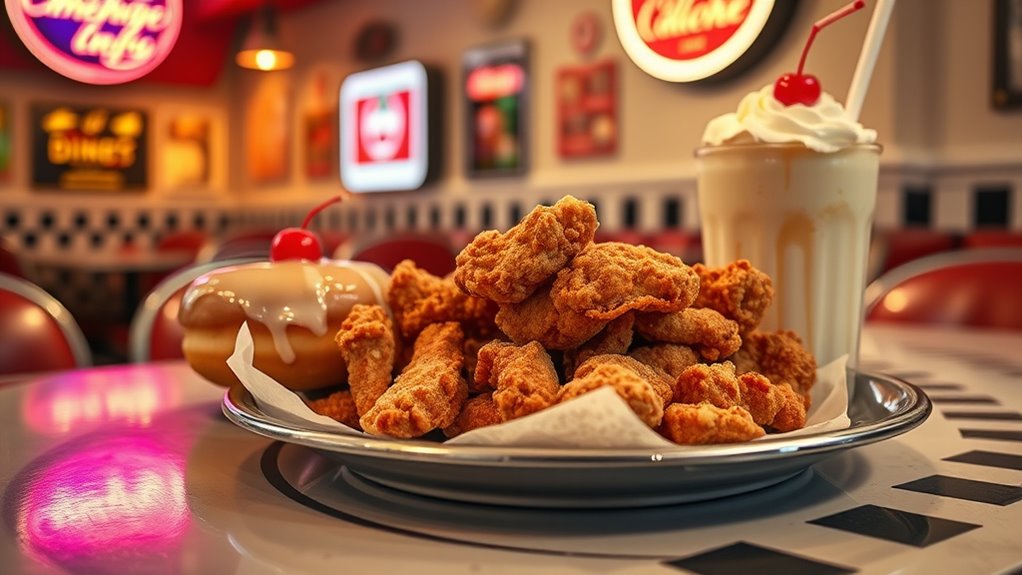You’re noticing how nostalgic comfort foods are making a big comeback, and it’s no surprise. Retro eateries with vintage packaging, classic menus, and lively 1960s-inspired atmospheres evoke childhood memories and create a cozy, familiar feel. Modern spots blend the old with new, using retro branding and recipes to attract diverse crowds. This trend celebrates tradition and offers a tasty link to the past. Keep exploring to discover why these flavors are capturing today’s attention.
Key Takeaways
- Nostalgic comfort foods evoke childhood memories and family traditions, creating emotional connections for consumers.
- Retro packaging and vintage branding enhance the dining experience, appealing to both sentimentality and visual appeal.
- The revival of classic recipes offers a warm, familiar taste that provides comfort amid modern life’s chaos.
- Incorporating retro elements into modern eateries attracts diverse audiences seeking authenticity and nostalgia.
- Retro eats serve as cultural artifacts, bridging past and present culinary experiences and celebrating timeless flavors.

Have you ever wondered what it’s like to step back in time through food? If so, you’re not alone. Retro eats are making a big comeback, and one of the most nostalgic ways to experience this is by visiting 1960s diners. These classic spots evoke a bygone era with their neon signs, checkered floors, and jukeboxes that still spin rock ‘n’ roll hits. But beyond their lively atmosphere, it’s the food that truly transports you. Many of these diners serve up dishes that have remained unchanged for decades, offering a taste of the past. What makes them even more authentic are the vintage packaging and branding that adorn their tables and takeout containers. These details are more than just decoration; they’re a connection to a simpler time when vintage packaging and convenience and familiarity mattered most.
Walking into a 1960s diner, you immediately notice the vintage packaging—think foil-wrapped burgers, glass soda bottles, and cardboard containers emblazoned with retro logos. These items aren’t just practical; they’re nostalgic artifacts. They evoke childhood memories for many, reminding you of family road trips or weekend outings. The packaging’s design, with bold fonts and bright colors, reinforces that sense of nostalgia, making even a quick bite feel like a special trip back in time. It’s this attention to detail that helps keep the spirit of the era alive, fostering a sense of comfort and familiarity.
Retro eats aren’t only about the visual appeal; they’re about flavor, too. The dishes served at these diners often feature timeless favorites like juicy cheeseburgers, crispy fries, and thick milkshakes. Many recipes have been passed down through generations, maintaining their original appeal. These foods taste like a warm hug, reminding you of simpler pleasures. And with the resurgence of vintage packaging, even takeout feels special. Orders come wrapped in wax paper or served in classic paper cartons, adding to the overall nostalgic experience.
Today, you’ll find that many modern eateries draw inspiration from these vintage establishments. They incorporate retro packaging, classic recipes, and decor that screams mid-century charm. This blend of old and new appeals to a broad audience enthusiastic to reconnect with their roots or simply indulge in a comforting, familiar meal. The revival of retro eats proves that sometimes, the best way to move forward is to look back. And for you, that means enjoying a delicious slice of history—served with a side of nostalgia.
Frequently Asked Questions
How Do Retro Foods Influence Modern Culinary Trends?
Retro foods influence modern culinary trends by fueling food nostalgia and inspiring a culinary revival. You’re likely to see chefs reinvent classic dishes with contemporary twists, blending old-school flavors with modern techniques. This trend encourages creativity in the kitchen and appeals to diners seeking comfort and familiarity. As a result, retro foods spark innovation while honoring tradition, making them a powerful force shaping today’s diverse and dynamic food scene.
Are There Health Concerns With Nostalgic Comfort Foods?
Yes, there are health concerns with nostalgic comfort foods. You might consume processed snacks high in sugar overload, which can lead to weight gain, diabetes, and other health issues. While these foods bring back fond memories, it’s important to enjoy them in moderation. Opt for healthier versions or balance your diet with fresh fruits and vegetables to mitigate the risks associated with traditional processed snacks.
What Are Some Lesser-Known Vintage Recipes Gaining Popularity?
You might be surprised to learn that regional specialties like Swiss fondue and forgotten desserts such as baked Alaska are gaining popularity. These lesser-known vintage recipes offer a delicious twist on nostalgia, tempting you to explore flavors past. Instead of sticking with mainstream comfort foods, why not indulge in these hidden gems? They bring a unique charm and a taste of history that’s just waiting to be rediscovered, one bite at a time.
How Does Nostalgia Affect Food Marketing Strategies?
You see, marketing nostalgia taps into consumer sentiment by evoking warm memories and emotional connections. When you target these feelings, you create a sense of familiarity and trust, making your products more appealing. By leveraging marketing nostalgia, you influence purchasing decisions, encouraging you to choose familiar, comforting foods. This strategy effectively boosts brand loyalty and sales, as it resonates deeply with your desire for comfort and connection.
Can Retro Foods Be Adapted for Dietary Restrictions?
Did you know 39% of consumers seek out dietary-friendly options? You can definitely adapt retro foods for dietary restrictions by creating gluten-free versions or vegan adaptations. Many brands now offer nostalgic treats that cater to these needs, making it easier for you to enjoy comfort foods without compromising your diet. So, whether it’s a gluten-free brownie or a vegan milkshake, retro favorites can be enjoyed by everyone.
Conclusion
So, what’s next for these beloved comfort foods? As nostalgia continues to influence our choices, one thing’s certain—you’ll want to keep an eye on the next big trend. Will classic recipes get a modern twist, or will new favorites emerge from the past? Whatever happens, one thing’s clear: your cravings for these retro delights aren’t fading anytime soon. Stay tuned, because the comeback story of comfort food is far from over—and you won’t want to miss what’s coming next.









